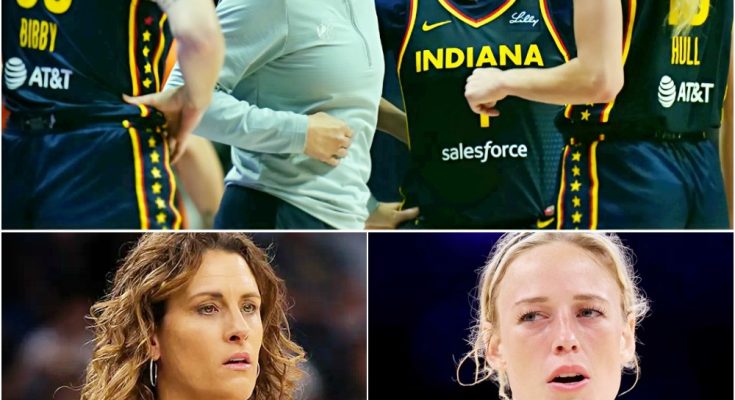
The arena didn’t go quiet because of the score. It went quiet because a camera shook, a coach’s voice cracked, and a single tear slid down faster than the broadcast could cut away. In the fan-shot footage that exploded across timelines, Stephanie White — the coach known for a steel face and tighter huddles — broke down the moment Sophie Cunningham’s name was said out loud. It wasn’t ceremony. It wasn’t spin. It was a rupture. And the room felt it. From that split second, the question that no one wanted to ask became the only one anyone could hear: what “hidden reason” sits behind those tears while a lawsuit already has the league on edge?
That night had started like any other mid-August clash. The Indiana Fever were on the road against the Connecticut Sun, fighting for survival in the regular season’s final stretch. The lights were bright, the crowd restless, and Caitlin Clark’s presence in the league had pushed television ratings into uncharted territory. The WNBA was enjoying more visibility than ever before. But visibility cuts both ways. Every foul, every injury, every reaction — nothing stays in the shadows anymore.
Midway through the first quarter, Sophie Cunningham went down. A reckless collision sent her crumpling to the hardwood, clutching her knee. She tried to stand but winced, biting her lip, forcing teammates to help her limp off. The stat sheet later showed she played only ten minutes. But numbers didn’t tell the story. What lingered was the silence — that heavy, unnatural hush that falls when a crowd knows they’ve witnessed something they weren’t supposed to.
What came later turned that hush into a firestorm. A shaky clip, recorded on a fan’s phone and uploaded to X, revealed what the official broadcast never showed. The Fever’s locker room after the game. White standing in the center, voice trembling, hands shaking. She tried to deliver one of her trademark speeches about grit and resilience, but the words broke apart. Her jaw quivered. She whispered “resilience” again, but this time the word sounded like it weighed five pounds. Then came the tears. She pulled a towel to her face too late. The phone had already caught the shine in her eyes. No one in the room moved. The clip ended there — but it was enough.
Enough to stop fans mid-scroll. Enough to freeze millions in front of their screens. Enough to light a fuse under an already combustible league.
Within an hour, the clip didn’t trend — it detonated. By morning, hashtags like #ProtectSophie, #WNBAJustice, and #StephanieWhite dominated timelines. Comment sections filled with timestamps — 0:03 (the crack in White’s voice), 0:07 (her hand missing the first tear), 0:11 (the collective exhale of the room). It wasn’t anger at first. It was eerie agreement — strangers silently acknowledging they’d just seen something too honest to ignore.
“This isn’t just emotion. White knows something we don’t.”
“If Sophie was in the NBA, this would already be a scandal.”
“That video is the WNBA’s worst nightmare. Nothing they say now will erase what we saw.”
Even ESPN couldn’t dodge it. One analyst admitted on air, “I’ve covered Stephanie White for years. I’ve never seen her break. For her to cry like that? It’s bigger than basketball.”
To understand why, you have to understand Sophie Cunningham. She isn’t just a roster piece. She’s Missouri’s pride, a player who embodies toughness and fiery passion. Loved by her fans, hated by some rivals, always in the middle of the storm. Her aggressive style draws cheers — and, critics say, draws too many suspiciously hard fouls. In recent weeks, clips had circulated of Sophie being shoved, tripped, elbowed. Fans insisted she was being singled out. Yet referees seemed to swallow their whistles.
Her sister finally broke the silence. In a sharp post on X, she wrote: “WNBA, maybe focus less on fining players for criticizing officiating and more on hiring refs who can protect athletes. Pathetic. Praying for you, Sophie.” The words hit like gasoline on dry wood. Outrage spread. Fans replayed old clips, journalists revisited ignored fouls, and suddenly the narrative crystallized: Sophie wasn’t just injured. She was targeted.
The lawsuit hanging over the league gave that narrative even sharper teeth. Months earlier, Caitlin Clark’s treatment had sparked legal action — allegations of inconsistent officiating, bias, and failure to protect athletes. The case simmered quietly but ominously, threatening to explode at any moment. Now, with Sophie Cunningham hurt and White in tears, whispers claimed Sophie’s name was surfacing in new legal documents. Nothing official had been published. No press releases, no filings. But in a vacuum of information, speculation breeds. Sports radio shows buzzed: Did White cry because she knows what’s coming? Did she see something buried in those files? Why now?
What surfaced next wasn’t a document — it was a pattern. Fans stitched together clips of missed whistles, late whistles, blatant fouls overlooked. Threads spread like wildfire. And then came the whispers from inside. A person familiar with game-ops phrasing — requesting anonymity — hinted at “internal language” about play safety that “rarely survives the recap.” It wasn’t an accusation. It was a nudge: look at what we record, and look at what we release.
Inside the Fever’s locker room that night, the silence spoke louder than words. A player fidgeted with her taped wrist as if the tape could muffle the tension. Another stared at the floor, eyes glassy and unblinking. White paced, started to speak, faltered, tried again. “We are resilient,” she finally said, and the word buckled in her throat. The towel rose to her face, but too late. A phone caught the fracture. And no one — not one teammate, not one staff member — moved to break the silence. It wasn’t grief alone. It was the outline of something none of them wanted to name.
By late afternoon the next day, quiet ripples had already formed. The players’ association formally requested access to game film from multiple angles. An officiating supervisor was spotted slipping into the arena’s service corridor with two referees — no statements, no press, just closed doors. A major sponsor quietly switched its social accounts from celebration mode to “monitor only,” shelving a planned graphic about record attendance. None of these actions hit the front page. But every move felt like movement — subtle proof that the footage had struck nerves beyond the locker room.
For the WNBA, the timing couldn’t be worse. Clark’s rise had pulled in record-breaking audiences. Sponsors lined up, TV networks finally leaned in, and 2025 was shaping up to be the season the league broke into true mainstream. Instead of victory laps, the headlines now screamed about lawsuits, officiating chaos, and viral footage of a head coach crying. Stability sells to sponsors. Scandal sells to fans. And the WNBA found itself straddling both in real time.
The whispers grew louder. Former players spoke out, saying they’d “seen this pattern before.” Analysts warned of “civil rights implications.” Every day the league remained silent, the theories multiplied. What made White cry? What “hidden reason” lay behind her collapse? Was it just Sophie’s pain? The weight of leadership? Or something darker — something no one dared speak, except in coded language and half-sentences?
For now, Sophie Cunningham is officially “day-to-day.” White has not addressed the footage. The league refuses to comment on lawsuits. The silence, ironically, speaks louder than any press release could. And in that silence, one question has become impossible to shake: what detail, buried in this lawsuit, could possibly leave the entire WNBA stunned from just a few seconds of footage?
The footage wasn’t meant to change the season. But it has.
The tears weren’t meant to mean more than emotion. But they do.
And the lawsuit wasn’t meant to touch Sophie Cunningham. But maybe, just maybe, it already has.
Until someone explains the tear, the footage will keep doing it for them.
Disclaimer: This article conveys the atmosphere surrounding the game, the reactions captured in public footage, and the conversations spreading across fan communities. It is presented as a reflection of how the moment has been perceived and discussed in real time.



